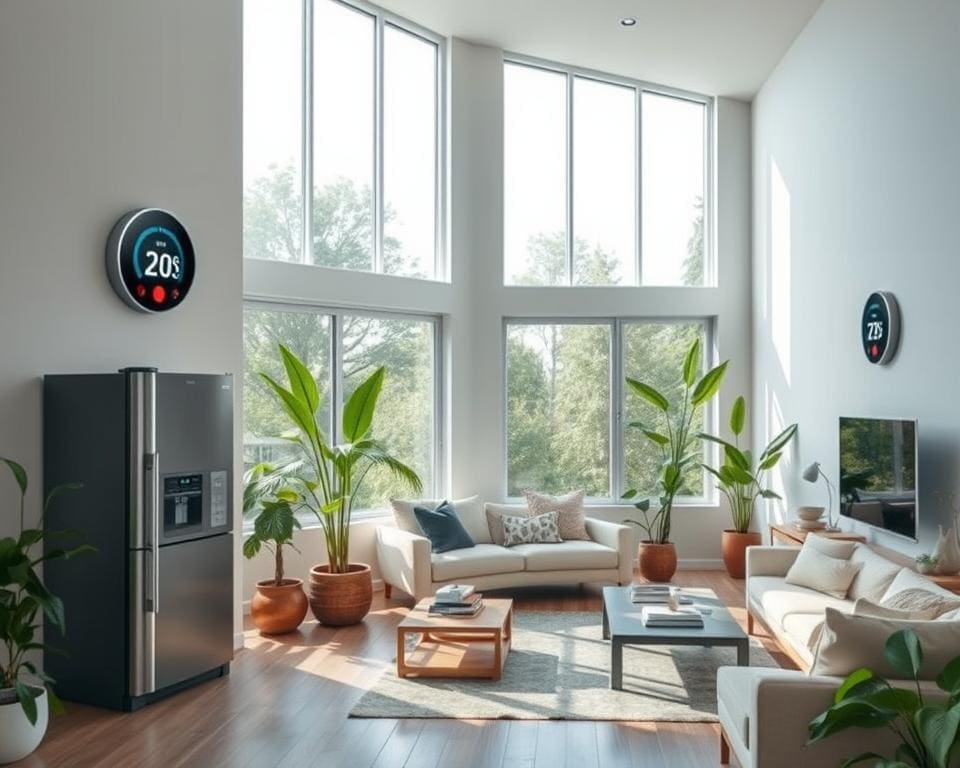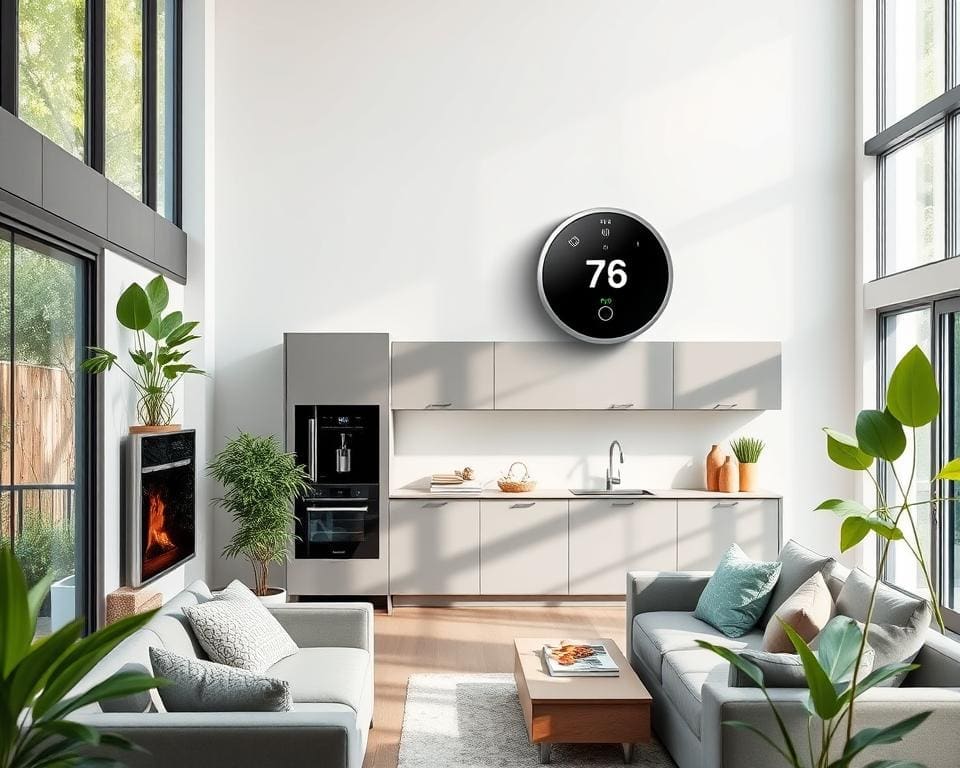In today’s world, where environmental sustainability is more crucial than ever, Smart Thermostats for Energy-Efficient Living have emerged as a vital solution. These innovative devices enable homeowners to manage their heating and cooling systems with unprecedented sophistication, promoting more effective energy usage. With a programmable thermostat, users can tailor their home’s climate to their specific needs, not only reducing energy consumption but also facilitating significant cost savings.
The growing popularity of smart thermostats reflects a collective shift towards eco-conscious home management. By harnessing the power of technology, individuals can contribute to a sustainable future while enjoying the comfort of a well-regulated environment. Embracing energy-efficient living has never been easier, making smart thermostats an indispensable tool in the quest for sustainability.
The Importance of Smart Thermostats in Sustainable Homes
Smart thermostats are revolutionising the concept of sustainable homes, making them more efficient and environmentally friendly. These devices significantly contribute to HVAC efficiency, effectively managing indoor climates without unnecessary energy consumption. By learning user behaviours and preferences, smart thermostats optimise heating and cooling schedules, preventing energy waste and ensuring comfortable living spaces.
Additionally, the integration of smart thermostats within the framework of eco-friendly heating solutions is a game changer. These technologies not only adjust temperatures based on real-time data but also allow users to monitor and manage energy usage remotely. This capability fosters a proactive approach to sustainability, empowering homeowners to make informed decisions that align with a greener lifestyle.
Adopting smart thermostats is crucial for future-proofing homes against the growing concern for climate change. With a focus on reducing carbon footprints, these devices serve as essential components in the push toward sustainable living. Through smart technology, the vision of a more efficient and environmentally conscious home is within reach.

Understanding Smart Thermostats for Energy-Efficient Living
Smart thermostats play a crucial role in modern households, particularly for those striving for energy efficiency. With the integration of smart home technology, these devices are transforming how we manage heating and cooling within our homes. Understanding their functionality can help homeowners take advantage of their many benefits.
What is a Smart Thermostat?
A smart thermostat is a Wi-Fi-enabled device that enables users to monitor and control their home’s heating and cooling systems remotely. Typically accessible via smartphone apps or voice commands, these devices provide a user-friendly interface to adjust settings based on personal preferences and schedules. Smart thermostats such as the Nest Learning Thermostat and Ecobee SmartThermostat are popular options that actively learn user habits, enhancing comfort while managing energy consumption effectively.
How Smart Thermostats Improve HVAC Efficiency
One of the primary advantages of smart thermostats lies in their ability to optimise HVAC efficiency. By gathering data on users’ behaviours and patterns, these devices automatically adjust temperature settings to ensure optimal energy usage without compromising comfort. Homeowners can significantly reduce energy costs while enjoying a more tailored living environment. Embracing this technology not only leads to better energy management but also contributes positively to sustainable living efforts.
Features of Programmable Thermostats
Programmable thermostats come packed with innovative features that significantly enhance your home’s comfort and energy efficiency. With these sophisticated devices, tailoring temperature control to fit your lifestyle becomes an effortless task.
Temperature Control Options
One of the most appealing aspects of a programmable thermostat is its variety of temperature control options. Users can set distinct schedules for different days, allowing for optimal heating and cooling patterns based on individual routines. For instance, reducing heat during the day while at work and warming up the home just before arrival means users enjoy a comfortable environment without wasting energy.
Integration with Smart Home Technology
This type of thermostat seamlessly integrates with various smart home technology devices, enhancing overall automation. Connection with security systems or smart lights allows users to create a cohesive smart home ecosystem. With a programmable thermostat, interaction with your home becomes even more efficient, offering convenience and peace of mind.
Remote Access and Control
Remote access through mobile applications allows users to manage their heating and cooling preferences from anywhere. Adjusting settings while on the go ensures your home remains at the ideal temperature upon your return. With the convenience of remote control, maintaining an energy-efficient home has never felt so simple.
Benefits of Using Energy-Saving Devices
Embracing energy-saving devices, such as smart thermostats, brings numerous advantages that enhance both personal finances and environmental wellness. Through these devices, households experience significant improvements in energy management.
Cost Savings on Energy Bills
One remarkable benefit of utilising energy-saving devices is the potential for impressive cost savings. Smart thermostats can help reduce energy bills by up to 30% annually. This financial relief stems from their ability to optimise heating and cooling schedules, ensuring energy is used efficiently without compromise to comfort.
Reduced Carbon Footprint
Adopting energy-saving devices plays an essential part in minimising the carbon footprint of a household. These devices encourage sustainable practices by actively managing energy consumption. By reducing reliance on fossil fuels for heating and cooling, homes contribute positively to global environmental conservation efforts.
Eco-Friendly Heating Strategies with Smart HVAC Systems
Embracing eco-friendly heating strategies has become essential for environmentally conscious homeowners. A smart HVAC system plays a crucial role in achieving energy efficiency while maintaining comfort. Integrating technology allows users to monitor and adjust their heating preferences effectively, significantly lowering energy consumption.
Zoning is one technique that optimises heating operations by allowing control over different areas of a home independently. This method ensures specific spaces receive adequate warmth without unnecessary energy wastage. Moreover, strategic temperature management can lead to a decrease in emissions, enhancing the overall sustainability of the heating system.
When paired with renewable energy sources like solar panels, the benefits of a smart HVAC system multiply. By harnessing renewable energy for heating, homeowners can further amplify their commitment to eco-friendly heating. This synergy not only reduces reliance on fossil fuels but also promotes a greener footprint in day-to-day living.
Choosing the Right Smart Thermostat for Your Home
When choosing the right smart thermostat, understanding the various key considerations is essential. Each home presents unique requirements, which can influence the decision-making process. From compatibility with existing HVAC systems to user interface simplicity, these factors will guide choices to ensure optimal comfort and efficiency.
Key Considerations Before Purchase
Before committing to a smart thermostat, keep the following points in mind:
- Compatibility with your current heating and cooling systems is crucial to ensure seamless integration.
- User interface preferences play a notable role in daily use; a more intuitive design will enhance the user experience.
- Consider features that align with your lifestyle, such as scheduling capabilities and energy-saving modes.
- Explore options for remote access, allowing monitoring and adjustments from anywhere.
Popular Brands and Model Comparisons
Several popular brands dominate the market for smart thermostats, each offering unique models tailored to various needs and budgets:
- Nest provides sleek designs and powerful learning algorithms to optimise energy use.
- Ecobee includes features like built-in voice control and room sensors for comprehensive climate management.
- Honeywell offers user-friendly options with great compatibility and a range of settings for personalisation.
Comparing models from these popular brands emphasizes features such as energy reporting capabilities and integration with existing smart home ecosystems. By taking the time to research and evaluate these smart thermostats, consumers can make informed decisions that enhance energy efficiency and comfort in their homes.
Setting Up Your Smart Thermostat for Success
Embarking on the journey of setting up a smart thermostat can significantly enhance energy efficiency in your home. The correct installation not only enables optimal performance but also maximises the potential savings on your energy bills. With our comprehensive installation guide, you’ll be well-equipped to transform your living space into a more sustainable environment.
Step-by-Step Installation Guide
Begin by ensuring the safety of your HVAC system; power it down to avoid any electrical mishaps. Once this is confirmed, carefully remove your existing thermostat and note the configuration of the wires for the new device. Connecting your smart thermostat to Wi-Fi is the next crucial step, which allows you to control it remotely through a smartphone app. Finally, dive into the app to configure user settings tailored to your preferences, ensuring that you enjoy the full benefits of your system.
Don’t overlook the importance of regular updates and maintenance checks after installation. This proactive approach not only extends the life of your device but also guarantees faultless operation. By investing a little time now in setting up your smart thermostat, you’ll ensure a substantial impact on your home’s energy efficiency and a more sustainable lifestyle going forward.









